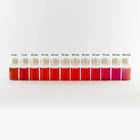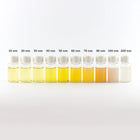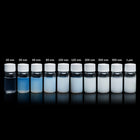This tool uses Mie Theory to calculate the optical cross-sections of single-component or core-shell spherical nanoparticles. The total extinction cross section is proportional to the optical density of a sample measured by standard UV-visible spectroscopy, and the calculator provides information on how the scattering and absorption components contribute to the total extinction.
Instructions
Select a Core material from the dropdown menu and enter the diameter in nanometers. If Other is chosen for the Core Type, enter the refractive index (RI) in the box (note this is the real refractive index only - no absorption component). If a Shell material is to be included, select the material and enter the thickness of shell in nanometers, or choose None if no shell is needed. Enter the starting and ending wavelengths of the spectral range to be calculated, and enter the refractive index of the media surrounding the particles. Press “Plot!” to calculate the extinction, absorption and scattering cross sections for a single particle. A csv file of the data can be downloaded; note that the cross-section units in the downloaded data are in units of m2/particle.
Material Properties
Dielectric values in the calculator are taken from literature, and multiple sources may be used for a given material to extend the range of wavelengths that can be used for calculations. The CRC Handbook of Chemistry and Physics and the RefractiveIndex.info website are useful references that provide information and literature sources describing the optical properties of a wide range of materials.
Citation
The Mie theory implementation used here was developed by Steve Oldenburg, Founder of nanoComposix, as part of his doctoral work at Rice University. More details on theory and code can be found in his dissertation, which can be cited as Oldenburg, S. J. Light Scattering from Gold Nanoshells. Diss. Rice University, 2000.




